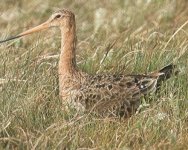In my local WHSmith I noticed a number of small field guides with photographs of birds, instead of paintings. I can see that this might increase accuracy in some ways, but I wonder about the faithfulness of the colours after the compromises of colour photography and colour printing, and I wonder if it might lead me to confuse features of the particular bird photographed with features of general use for identification.
Any comments? (I actually went in planning to buy a more recent Collins Gem guide than the one I carry everywhere in my jacket pocket, but they didn't have that one. The most compact book they had was 'Britain and Europe' and I resent carrying around pages whose only effect in this country will be to distract and confuse me). I would carry a guide even if I was expert (I'm not) because "the palest ink is better than the best memory". Anyway, it gives me something to read in checkout queues.
Any comments? (I actually went in planning to buy a more recent Collins Gem guide than the one I carry everywhere in my jacket pocket, but they didn't have that one. The most compact book they had was 'Britain and Europe' and I resent carrying around pages whose only effect in this country will be to distract and confuse me). I would carry a guide even if I was expert (I'm not) because "the palest ink is better than the best memory". Anyway, it gives me something to read in checkout queues.







